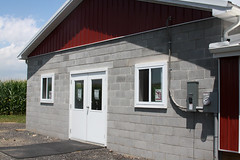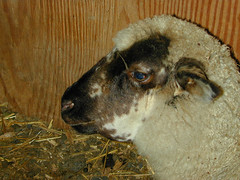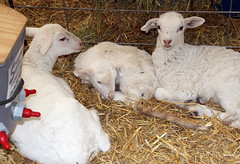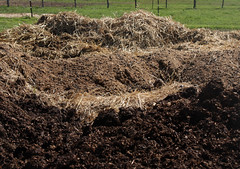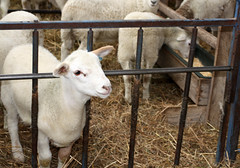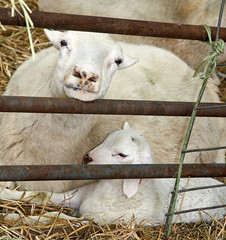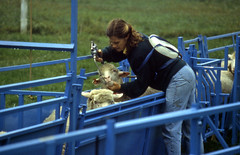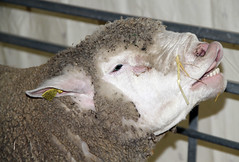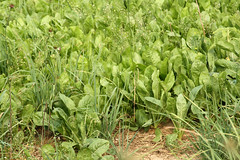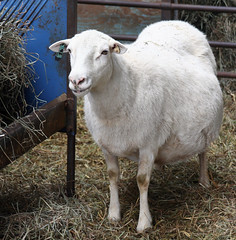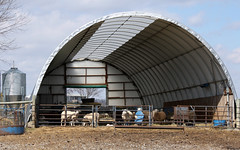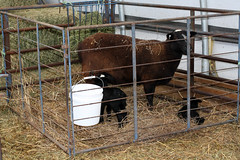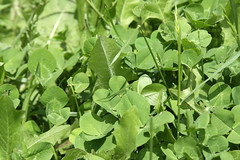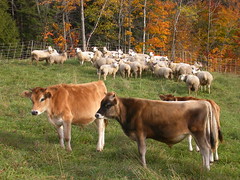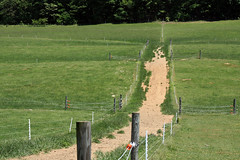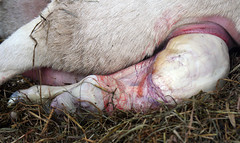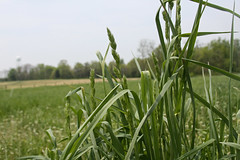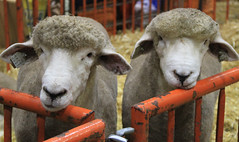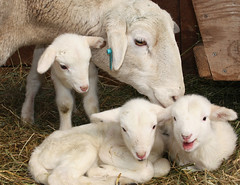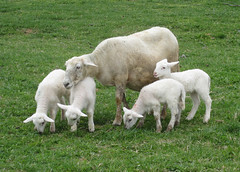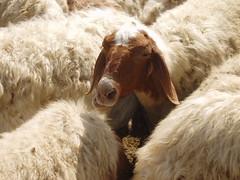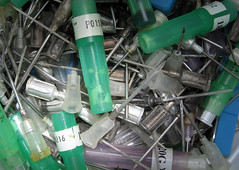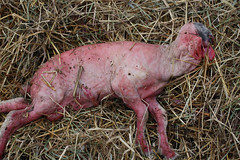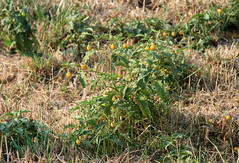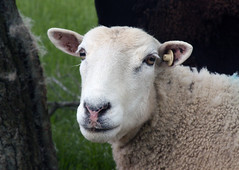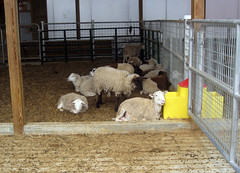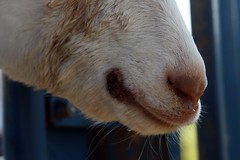- Sheep 201 Index
- Other web sites

Feed lot

Ultrasound
Glossary of Sheep Terms
A B C D E F G H I J K L M N O P Q R S T U V W X Y Z
A
Abattoir -a facility where farm animals are harvested and processed into meat products.
Abomasum - the fourth compartment of the stomach of a ruminant; the one where digestion takes place.
Abortion - premature loss of a pregnancy.
Accelerated lambing - when a ewe lambs more often than once a year.
ADF - acid detergent fiber
AFO - Agricultural operations where livestock are kept and raised in confined situations. Some states regulate AFOs.
Afterbirth - the placenta and fetal membranes that are expelled from the uterus after the lambs are born.
Amino acid - one of the building blocks of protein.
Anemia - a lower than normal number of red blood cells.
Animal unit (AU) - a unit represented by one mature cow or horse, or by as many animals as consume an equivalent amount of feed, such as 7 sheep.
Animal unit month (AUM) - The quantity of forage required by one mature cow and her calf (or the equivalent, in sheep or horses, for instance) for one month.
Annual (plant) - a plant that usually germinates, flowers and dies in one year.
Anthelmintic - a medicine which kills certain types of intestinal worms.
Antibiotic - a drug that kills bacteria and other germs.
Antibodies - proteins produced by the immune system to fight specific bacteria, viruses, or other antigens.
Anti-toxin - an antibody that can neutralize a specific toxin.
Artificial Insemination (AI) - process whereby semen is placed within a female's uterus by artificial means i.e. other than sexual intercourse.
ASI - American Sheep Industry Association. Federation of state sheep associations.
Ataxia - inability to coordinate muscle movements
B
Bale (wool) - baled form of sheep fleeces. Usually 200-400 lbs.
Baleage - forage harvested at higher moisture than dry hay. Baled and wrapped in plastic.
Banding - the process of applying rubber bands to the tail or scrotum for docking and castrating.
Bellwether - sheep that leads the herd often wearing a bell.
Blackfaced - sheep expressing genetics of one of the blackfaced breeds, e.g. Suffolk
Bloat - excessive accumulation of gases in the rumen of an animal.
Blue bag - gangrene of the udder
Blue tongue - viral disease caused by insects
Bottle jaw - Edema or fluid accumulation, under the jaw. A sign of infection with Haemonchosis in sheep.
Breech birth - a birth in which the lamb is presented backwards with its rear legs tucked under and only its tail near the opening.
Browse - parts of woody plants, including twigs, shoots, and leaves.
Buck - slang term for a male sheep.
Bummer (bum lambs) - slang term for an orphan lamb.
Burdizzo - castration method that uses a large clamp to crush the blood vessels leading into the testicles.
C
Caesarian section -surgical removal of lambs from abdomen
CAFO - cconfined animal feeding operation having at least 1,000 animal units. Governed by federal and state laws.
Carding -process involving the movement of natural fibres between two surfaces covered with wire pins in order to detangle and align the fibres in preparation for spinning.
Cast - sheep that has fallen on its back and cannot get up
Castrate - removal of testicles or influence of testicles.
cc - cubic centimeter. Same as a millileter (ml).
CDT - common vaccine for clostridial diseases
Cellulose - component of plant cell walls that is not digestible by most animals (lignin)
Cervix - the lower section of the uterus which protrudes into the vagina and dilates during labor to allow the passage of the fetuses.
CIDR - progesterone implant. Use to induce and synchronize estrus.
Coccidiostat - any of a group of chemical agents mixed in feed or drinking water to control coccidiosis in animals.
Colostrum - first milk a ewe gives after birth. High in antibodies, this milk protects newborn lambs against diseases.
Composting - process whereby organic wastes decompose naturally.
Combing - the straightening or parallelizing of fibers using combs. Also includes the removal of short fibers and other impurities.
Concentrate - feed that is high in energy, low in fiber content, and highly digestible.
Conception - in reproduction, the point at which a sperm fertilizes an egg.
Continuous grazing - livestock remain on a grazing unit the entire time in which grazing is allowed.
Cool season plant - a plant that generally makes most of its growth during the late fall, winter, and spring.
Corpus Luteum (CL) - the mass of cells that form once the egg has been released from the ovary. The corpus luteum produces progesterone. Also called "yellow body."
Cost share - a subsidization, by different governmental agencies and some private industries.
Creep gate - gate that allows lamb access, but keeps their mothers out.
Creep feeding - to provide supplemental feed to nursing lambs.
Creep grazing - the practice of allowing young animals to graze areas their dams cannot access at the same time.
Crimp - the natural waviness of the wool fiber.
Cryptorchidism - failure of one or both testes to descend
Culling - the process that determines which animals in a herd will not be bred.
Cull ewes - ewes that have reached the end of their productive life.
Crossbreeding - the mating of animals of different breeds.
Crossbred - animal that is a combination of two or breeds.
Crutching (or crotching) - the removal of wool from around the tail and between the rear legs of a sheep.
Cud - food of a ruminant regurgitated to be chewed again.
D
Dags - wool contaminated with feces, which is either adhering to or has been clipped from the posterior of sheep.
Dam - mother.
DE - digestible energy
Diarrhea - increased frequency, fluidity, or volume of fecal excretion.
Dock - to remove the tail (v) or the shortened tail of a sheep (n).
Drench - a method of giving liquid medicine (v). A form of dewormer given orallly (n).
Dressing percentage - the percentage of the live animal that ends up as carcass.
Dystocia - difficulty in giving birth or being born.
E
Eid - annual Islamic festival. There are two major Eids in the Muslim calendar.
Elastrator - instrument used to apply heavy rubber bands (elastrator rings/bands) to the tail and scrotum for docking and castration.
Electrolyte - essential salts for the body
Embryo - an animal in the early stage of development before birth.
Embryo Transfer (ET) - implantation of embryos or fertilized eggs into a surrogate mother.
Entropion - when eyelid is turned in.
Epididymitis - tiny tube where sperm collect after leaving the testis.
Estrogen - female sex hormone produced by the ovary. Responsible for the estrus cycle.
Estrus - the period when the female is fertile and receptive to the male. Also called heat.
Estrus Cycle - the reproductive cycle of the female.
Ewe - female sheep
Extra label - use of a drug in a manner for which it was not labeled. Only veterinarians can use or prescribe extra label drugs.
F
FAMACHA© - a parasite control regime for controlling and treating Haemonchus contoritus in small ruminants. Uses an eye color chart to predict level of anemia in animal.
Fat-soluble vitamins - vitamins that dissolve in liquid fat or fatty oils, in addition to water. They include Vitamin A, D, E and K. They are manufactured in the rumen.
Fatten - feed for slaughter. Make fleshy or plump.
Fecal egg count (FEC) - number of worm eggs in a gram of feces. Also called EPG (eggs per gram).
Fecundity - producing abundance of offspring
Feedlot - an area where lambs are confined and fed carefully mixed, high-concentrate feed to fatten them.
Fertilization - fusion of egg and sperm to form zygote
Fertilizer - any one of a large number of natural and synthetic materials, including manure and nitrogen, phosphorus, and potassium compounds, spread or worked into the soil to increase its fertility.
Five Point Check© - an extension of the FAMACHA© system, a decision-making tool that allows farmers to make deworming decisions for all of the parasites that commonly affect small ruminants. Involves five check points on the animal's body: eye, jaw, nose, back, and tail.
Fleece - the wool from a single sheep in the shorn grease state.
Flerd - a mixed group of sheep and cattle.
Flushing - increasing nutrition prior to and during the early part of the breeding season.
Fodder - crops grown for animal feed.
Follicle stimulating hormone (FSH) - hormone produced by the pituitary gland which stimulates the production of follicles by the ovary.
Foot bath - chemical and water mixture that sheep stand in, used for the prevention and/or treatment of foot rot and foot scald.
Footrot - contagious disease of sheep caused by specific bacteria
Forage - grasses, small shrubs and other plant material that can be used as feed for livestock. Edible parts of plants.
Forb - broadleafed herbaceous plant (e.g., dandelion).
Forward grazing - when one group of animals is allowed access to a paddock ahead of another group.
G
gauge - thickness of a needle. The smaller the gauge the thicker the needle.
Gestation - the length of pregnancy.
Gimmer - female sheep over one year of age.
Grade (n) - measure of quality. There are grades for live animals, meat, and wool.
Graft - to transfer a lamb to a ewe that is not its mother.
Grain - the seed part of cereal crops such as corn, oats, barley, and wheat.
Grass - a group of plants having narrow leaves with parallel veins, small flowers, and basically hollow stems with joints where the leaves are attached.
Grass-based - when pasture or grassland play a significant role in the life or diet of the animal.
Green chop - freshly cut forage fed to livestock.
Ground water - water that does not run off, and is not taken up by plants, but soaks down into an aquifer; a supply of fresh water under the earth’s surface which forms a natural reservoir. Is frequently used for drinking.
Gummer - a sheep so old that it has lost all of its teeth.
H
Haemonchosis - infestation with or disease caused by nematode Haemonchus (esp. H. contortus)
Halal - a set of Islamic dietary laws which regulate the preparation of food.
Hand spinner - a person who spins wool (twists fibers into yarn) by hand.
Hay - grass mowed and cured for use as fodder.
Haylage - grass silage
Heat - estrus. The period when the female is fertile and receptive to the male.
Heavy use area - an outdoor area where livestock are primarily sustained by imported feed.
Hectare - metric unit of area equal to 10,000 square meters, or 2.471 acres
Heterosis - an increase in the performance of hybrids over that of purebreds, most noticeably in traits such as fertility and survivability.
Heritability - the extent to which a trait is influenced by our genetic makeup.
Hogget - a British term for a yearling sheep that has not yet been shorn.
Hoop house - building with an arched metal frame and fabric cover, used to house livestock.
Hormone -a substance that is made by one part of the body but affects another part of the body.
Hull - the dry outer cover of a fruit, seed, or nut.
Hybrid vigor - an increase in the performance of hybrids over that of purebreds, most noticeably in traits such as fertility and survivability.
Hypothermia - a condition of characterized by low body temperature.
I
Immunity - a natural or acquired resistance to a specific disease.
Inbreeding - Mating or crossing of individuals more closely related that average pairs in the population.
Intramuscular (IM) - into a muscle.
Intraperitoneal (IP) - administered or withdrawn from within the abdominal cavity.
Intravenously (IV) - entering through a vein.
Islam - the religious faith of Muslims, literally, "submission" (to God)
IU - international units (0.67 mg). Used for fat-soluble vitamins
J
Jug - a pen where a ewe and her newborn lambs are put to bond.
Jugular - vein in the neck that returns blood from the head.
K
Ked - wingless fly that is an external parasite on sheep.
Ketone - acidic substance produced when the body uses fat, instead of sugar for energy.
Ketosis - metabolic disorder where ketones build up in the body.
Kosher - food prepared in accordance with Jewish dietary laws.
L
Lactation - the secretion (production) of milk. When the ewe is giving milk.
Lamb - a young sheep (n). To give birth to a lamb (v). The meat from an animal less than one year old (n).
Lanolin - wool "grease." Also called yolk.
Larvae - the immature form of many animals, which hatches from the egg and often differs in appearance from the adult form.
Leader-follower - when two classes of livestock having distinctly different nutritional needs are grazed successively in a pasture.
Legume - a plant whose roots form an association with soilborne bacteria that can capture atmospheric nitrogen.
Libido - sexual desire.
Lignin - a component of the cell walls of plants that occurs naturally, along with cellulose.
Linebreeding - the mating of individuals within a particular line.
Live vaccine - a vaccine in which live virus is weakened through chemical or physical processes in order to produce an immune response without causing the severe effects of the disease.
Lutenizing hormone (LH) - The hormone that normally triggers ovulation and stimulates the corpus luteum to secrete progesterone. In the male, it stimulates testosterone production.
M
Macromineral - an element essential in large quantities. Includes Ca, Mg, P, Na, Cl, and K.
Mark - when lambs are worked for the first time: ear tagging, docking, castrating
Mastitis - Inflammation of the mammary glands.
ME - metabolizable energy
Meat and bone meal - the rendered production from animal tissues, including bone.
Microminerals - minreals needed in very small quantities. Also called trace minerals. Includes Fe, Co, Cr, Cu, I, Mn, Se, Zn, and Mo.
Micron - one millionth of a meter. Measurement unit for wool fiber diameter.
Milliliter (ml) - a unit of liquid volume in the metric system equivalent to one thousandth of a liter or approximately .03381 fluid ounces in the English system.
Mixed grazing - grazing by two or more species of grazing animals on the same unit of land . Also called multi-species grazing.
Mob - a group of sheep that have been run under exactly the same conditions for the entire growing season.
Moorit - brown.
Morphology - the size and shape of sperm.
Motility -the ability of sperm to move by themselves.
Mottled-faced - having spots or patches of color on the face.
Muslim/Moslem - a follower of the Islamic faith.
Mutton - the meat from an older sheep.
N
NAIS - National Animal Identification System.
NDF - neutral detergent fiber
NE - net energy
NSIP - National Sheep Improvement Program. A computerized genetic evaluation program for sheep.
Necropsy - a postmortem examination.
Nematode - roundworm.
Nutrient management - identifying how the major plant nutrients (nitrogen, phosphorous and potassium) are to be annually managed for expected crop production and for the protection of water quality.
O
Omasum - the third part of the ruminant stomach located between the reticulum and the abomasum.
Orf - a viral skin disease affecting sheep and goats. People can contact this disease.
Organic matter - the part of the soil that includes the decomposing remains of plants and animals, as well as the product of complete decomposition, known as humus.
Orthodox - referring to the Eastern Church.
Ova - female sex egg. Also called ovum, oocyte.
Oviduct - tube though which the egg (ovum) passes from an ovary. Also called fallopian tube in humans
Ovine - of, pertaining to, resembling, or being a sheep
Ovis - a taxonomic genus wthin the sub family caprinae -- the sheep
Ovulation - the release of mature eggs from the ovary.
Oxytocin - a naturally secreted hormone that is important in milk letdown and the contraction of the smooth uterine muscles during the birthing process.
P
Paddock - an enclosed area for grazing animals.
Parturition - the act of giving birth.
Pedigree - line of descent of a purebred animal.
Pelt - the skin of a sheep with the wool on.
Perennial plant - plant that lasts three seasons or more.
Periparturient - around the time of giving birth.
pH - a value that indicates the acidity of something (e.g. rumen, soil).
Phenotype - the observable characteristics of an individual.
Photoperiod - the relationship between the length of light and dark in a 24-hour period.
Pinkeye - condition in which the conjunctiva (membranes lining the eyelids and covering the white part of the eye) become inflamed or infected. Also called conjunctivitis.
Pizzle - the penis of an animal.
Placenta - the organ that nourishes the fetus(es) in the uterus.
Pneumonia - an infection in the lungs.
Polled - the abscence of horns.
PPM - part per million (1 mg per kg)
Predator - an animal that lives by killing and eating other animals.
Probiotic - living organisms used to manipulate fermentation in the rumen.
Progeny - the offspring of an individual.
Progesterone - a female hormone secreted by the ovary. Produced in large quantities by the placenta during pregnancy.
Prolific - producing offspring in abundance.
Protozoa - the first animals; the lowliest forms of life, all single-celled.
Purebred - wholly of one breed or line (as opposed to crossbred).
Q
Q fever (Query fever) - an infectious disease that spreads from animals to humans. Caused by a microbe called Coxiella burnetti.
R
Raddle - color pigment that is applied to the ram's brisket to mark females he mates.
Ram - uncastrated adult male sheep
Ram effect - stimulating non-cycling ewes to ovulate by the sudden introduction of a ram or teaser ram.
Recessive gene - gene whose effects are masked by a dominant gene
Refugia - worms that have not been exposed to anthelmintics and therefore are susceptible to drug treatment.
Reticulum - the second chamber of the ruminant digestive tract, used for sorting out fine plant particles for further fermentation.
RFID - radio frequency identification. Refers to the technology that uses devices attached to objects that transmit data to an RFID receiver.
Ringwomb - failure of the cervix of a ewe to dilate during parturition.
Rotational grazing - a grazing scheme where animals are moved from one grazing unit (paddock) to another.
Roughage - feed that is high in fiber, low in digestible nutrients, and low in energy (e.g., hay, straw, silage, and pasture).
Roundworm - unsegmented worms with elongated rounded body pointed at both ends.
Rumen - the first compartment of the stomach of a ruminant animal. Tts bacteria and protozoa break down cellulose.
Ruminant - an animal with a multiple stomach that is able to digest cellulose.
S
Safe pasture - pasture that is not infected with worm larvae.
Scouring - the actual separation of dirt, grease, and foreign matter from grease wool.
Scours - diarrhea in livestock.
Scrapie - the TSE of sheep and goats. A fatal brain disease.
Scrotum - pouch in which the male's testicles are suspended outside the body.
Scurs - little horns that have broken the skin, but not grown.
Second cuts - short tufts of wool cut at least twice by the shearing.
Selection - choosing of favorable offspring as parents for future generations.
Selection differential - the difference between the mean of the individuals selected to be parents and the mean of the overall population.
Selection index - a linear combination of phenotypic information and weighting factors used for genetic prediction.
Semen - the combination of sperm, seminal fluid, and other male reproductive secretions.
Sharps - needles, syringes, scalpel blades, slides, pipettes,and anything else that can puncture the skin.
Shear - the act of cutting wool.
Sheath - an enveloping structure or covering enclosing an animal organ or part.
Shed lambing - housing ewes and newborn lambs in pens or sheds to provide food, shelter, and medical care during and immediately after birth.
Sheepherder - person who is a herder on open range; keeps the flock together.
Shepherd - person who cares for sheep.
Short-scrotum - ram whose testicles have been pushed up inside the body cavity and has his scrotum removed.
Silage - fodder (livestock feed) prepared by storing and fermenting green forage plants in a silo.
Sire - father.
Skirting - removing the stained, unusable, or undesirable portions of a fleece.
Slime graft - rubbing the fetal fluids and membrane of a ewe's lamb onto a lamb that you wish to graft onto her.
Smut-faced - blackface x whiteface
Somatic cell count - the number of white blood cells per milliliter of milk or measurement of the number of somatic cells present in a sample of milk.
Sperm - male reproductive cells.
Spermatogenesis - sperm production
Spin - work natural fibers into thread or yarn.
Staple - refers to the length of a lock of shorn wool; in the trade, "staple" refers to the longer length wools within a grade.
STAR© System - accelerating lambing system in which ewes produce five lamb crops in a three year period.
Stillborn - showing no signs of life at birth.
Stocking density - the relationship between the number of animals and area of land at any given time.
Stocking rate - the number of specific kinds and classes of animals grazing a unit of land for a specified period of time.
Stockpiled forage - forage that is allowed to accumulate for later grazing.
Straw - the stems of wheat, barlely, or oat plants which are cut and baled and often used for animal bedding. Sometimes, straw is fed to animals.
Strip grazing - confining animals to an area of grazing land to be grazed in a relatively short period of time.
Stun - make senseless.
Subcutaneous (sub-Q, SQ) - under the skin.
Sustainable agriculture - an approach to growing food and fiber which is profitable, uses on-farm resources efficiently to minimize adverse effects on the environment and people, preserves the natural productivity and quality of land and water, and sustains vibrant rural communities.
T
Tapeworm - ribbonlike flatworm that is parasitic in the intestines of vertebrates.
Targeted Selective Treatment (TST) - treatment strategy in which only animals which require treatment (usually deworming) or would benefit from treatment are treated.
Teaser - ram that have been surgically altered in a way that prevents him from reproducing.
Testosterone - a hormone that promotes the development and maintenance of male sex characteristics.
Top - a strand of longer fibers that have been straightened, made parallel and separated from the shorter fibers by combing.
Top dress - a process that means apply to the top.
Total Digestible Nutrients (TDN) - standard system for expressing the energy value of feeds.
Toxoid - A substance that has been treated to destroy its toxic properties but retains the capacity to stimulate production of antitoxins, used in immunization.
Trace minerals - minerals need in very small quantities (ppm or IU). Includes Fe, Co, Cr, Cu, I, Mn, Se, Zn, and Mo.
Tup - British term for an uncastrated adult male sheep.
U
Udder - the milk secreting organ of a cow or sheep.
Ultrasound -a procedure in which high-energy sound waves (ultrasound) are bounced off internal tissues or organs and make echoes.
Urea - chief end product of mammalian protein metabolism.
Uterus - the organ in the female in which the fetuses develop. The womb.
V
Vaccine - injection given to animals to prevent or cure diseases.
Vagina - the canal that forms the passageway from the uterus to the outside of the body. The birth canal.
Vegetable matter - any material of plant origin found in the fleece, such as burrs, stickers, chaff and seed heads.
Vegetative - in developmental stages of plant growth. Non-reproductive plant parts, i.e. leaf and stem; in contrast to reproductive plant parts, i.e. flower and seed.
VFA - volatile fatty acid. Product of rumen fermentation.
W
Warm season plant - a plant that makes most of its growth during late spring, summer, or early fall and is usually dormant in winter.
Weaning - removal of young mammals from their source of milk.
Weed - a plant that is growing where it is unwanted.
Wet graft - immersing the lamb to be grafted, along with the ewe's own lamb, into a saturated salt solution.
Wether - a castrated male sheep.
Whitefaced - sheep expressing genetics of one or more of the whitefaced breeds.
Withdrawal period - the time when a drug must not be administered prior to marketing to insure that no drug residues remain in the meat or milk.
Wool pool - a collection point for many producers to sell their wool.
Woolen - yarn made from fibers that are one to three inches in length and that have been carded only. Fabrics of woolen yarn are characterized as being fuzzy, thick, and bulky.
Worsted - wool yarn of long staple with fibers that have been combed prior to spinning. Combing produces more parallel fibers than carding.
X
Y
Yearling - an animal between 1 and 2 years of age.
Yeast - single-cell fungi that improve food digestion by stimulating microbial activity.
Yoe - slang term for an adult female sheep.
Z
Zero grazing - a method of raising livestock in pens or small corrals where most of their fodder is grown elsewhere and carried to the pen.
Zoonoses - a disease that is transmissible between humans and animals.
Zygote - fertilized egg
Copyright© 2021. Sheep 101 and 201.

